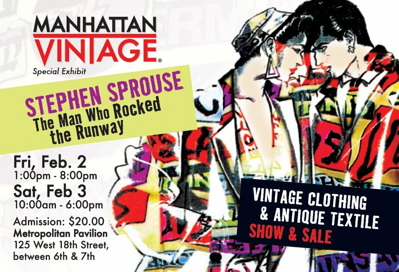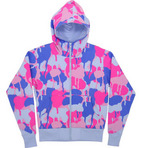Polo Dress by Kate Hartman, Chanel Necklace by Kelly Tuohy, both for Hacking Couture. Photographer: Maria MayerMake-up: Chiho OmaeStylists: Giana Gonzalez and Michal Bril
In the 1990s, open source code for software resulted in vast technological improvements by encouraging a dialogue between participants through its free documentation and distribution. Inspired by the inherent democratic nature of open source theory, Hacking Couture seeks to apply the same concept to fashion. The purpose of Hacking Couture is the "documentation of the design code of established identities in order to derive new and evolving fashion aesthetics, serving also as a platform for self-expression and nest for new ideas."Hacking Couture was created by Giana Gonzalez, a graduate student in NYU's Interactive Telecommunications progam. Fashion Projects spoke with Giana recently about her reasons for wanting to hack into the fashion system.
After the jump, read more about the challenges she faced in developing the code, the successful hacks that have occurred so far, and what Hacking Couture has planned for the future.
What was your inspiration in creating Hacking Couture?
My inspiration for Hacking Couture is rooted in a personal need to connect with others and with my background. I grew up in a different culture (I am from Panama), but I knew back then about international fashion through publications like Vogue and Harper's and through the music videos on MTV. So while I was aware of a common [aesthetic] language, there was no physical way for me to connect with what I saw in these publications or even find other people who were also interested in the same things.
Thus, I would experience fashion and performance in an isolated manner: all alone in my bedroom. This was fun because it allowed my imagination and creativity to fly... really high! Through imitation I generated my own versions of the clothes and performances that were thrown at me by the media, and the results would be interesting creations that would never turn out the same as the ones I had tried to imitate. Instead the creation would evolve into something else entirely new. Unfortunately I was never able to share these experiences with like-minded people.I feel fashion is about much more than just consuming.
Today we have the excitement and endless potential of wearable technology, which adds magic to the mundane, generating magical moments through everyday clothing and accessories. There is also the potential for collaborative experiences at a different level and purpose from what the current fashion industry model dictates. There is room for playfulness and creativity, leading towards personal and collective expression and exploration. With all the potential that the internet offers, I feel the connectivity and dialogue I had missed can actually happen now, as well as help others to connect and help express themselves. Through a common design language I want to give myself and others the opportunity to connect over something as fun and liberating as fashion.
How do you determine the code? Is the code fluid or fixed?
The code available at the open source library is determined by academic research and by a study of the designer's most repetitive design elements that appear in diverse media - from print ads to television and web appearances.Currently users cannot update the existing code.
The current structure of the documented code is static, but we are working on a way to allow the public to input ideas or new elements into the code. Ultimately there will be a fluidity, as the library will document both existing and revised codes.This is just one of the challenges of this project. The main challenge is trying to reverse-engineer a brand by creating a strict set of design rules which are then broken to some degree. First, we must determine the digital (or visual) aspects of a brand, for example Chanel's main color scheme is white on black. The next step is documenting the analog aspects of the code, which we do through looking at the representations of a designer’s works in advertising and editorials.
One piece that appears to be left out of the codes (for obvious reasons) is the personality of the original designer. For example, beyond just the designs, the personalities of Gabrielle Chanel and Karl Lagerfeld have been integral to the success of the brand Chanel. Do you think that this is an inherent flaw in the hacking couture system, or something that can be exploited?
Actually, all the design guidelines are a result of the designer's "lifestyle" and philosophy, or at least what they want to convey within their stories, through their design. Diagrams like the one for Polo, will be more helpful in understanding how certain pieces reflect the lifestyle of the designer.
The Polo hack does it by showing how Ralph Lauren conveys the idea of old money through using a logo that represents a polo player. Also Gabrielle Chanel's diagram speaks to her design influences. For example, many of the men she was involved with defined her directions in design. But you make a good point that unless you have this kind of background you won't connect the dots, so I will consider this for the next iteration.
What do you consider a successful hack? What was your most successful hack?
For Hacking Couture a successful hack is when a designer/contributor includes the core elements of the design code as part of their design, although they do not have to include all of them. To a certain extent, the new creations are "part" of the same species, but not exactly of the same kind - anyone can visually connect the elements of the design and then relate them to the same family. Personally, they were all successful, because the hacks kept some of the important "code" of the original designer/brand.
The ultimate goal of the hack is to enhance creativity and collaboration that will eventually catalyze an evolving aesthetic. If the hack inspired you to make something and feel proud about it .... then that is considered a successful hack.Among Hacking Couture's proposed hacks, my favorite is the YSL Bow-Purse. The workshops we put on had surprising outcomes – it was rewarding to see the contributors' creations come to life. Some of the more successful hacks that come to mind are Kate Hartman's Polo dress, Megan MacMurray's rugby shirt and Gabe Barcia's Punk Polo shirt.
What future hacks do you have planned?
The concept of performance is coming up. The lifestyle of a brand could be explored and represented through performance, so let's hack that! This will help find a new way to document the lifestyle aspect of a brand. In terms of content . . . Italian Hacking is coming up. . . Italian design is sensuous and contemporary.... so let's see how the 2008 Brainstormed HC Collection embraces it!
Interview conducted by Sarah Scaturro for Fashion Projects. For more information on Hacking Couture go to www.hacking-couture.com










